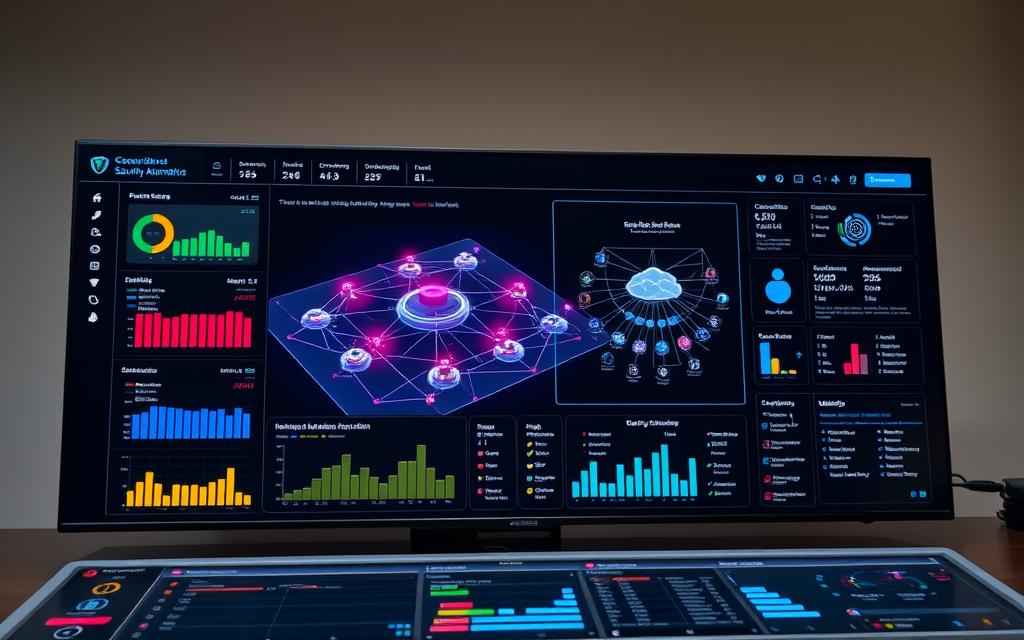Modern societies depend on essential technology systems for daily life. These systems keep hospitals running, transport networks moving, and ensure electricity flows. They are the backbone of our lives, making critical infrastructure protection key for national stability.
In Canada and the U.S., critical infrastructure is seen as physical and digital assets vital for public safety and economic health. For example, the National Critical Technologies List highlights energy grids, healthcare networks, and communication platforms as top priorities. These systems are so connected that a cyberattack on power stations could affect water treatment plants in just hours.
Protecting these assets is more than just preventing outages. It’s about keeping data safe in financial institutions, securing medical equipment supply chains, and defending against threats. Governments now focus on resilience planning. They understand how weaknesses in one area can lead to bigger crises affecting national security.
Defining Critical Technology in Modern Infrastructure
Modern societies rely on systems that keep things running smoothly. These critical technologies include hardware, software, and networks. They are key to keeping our country stable. It’s important to understand how failures in one area can affect others.
Core Concepts and Scope
Public Safety Canada lists 10 critical infrastructure sectors. These range from energy grids to financial systems. Operational technology (OT) is a big part of this, controlling physical processes in industries.
OT is different from IT because it directly manages things like power plants and water treatment facilities.
Three key things define critical technologies:
- They need to keep running 24/7
- Stopping them can have big impacts
- They involve many different groups
Examples of Critical Technologies
The 2021 Colonial Pipeline attack showed how operational technology can fail. It stopped fuel from getting to many states. Other important systems include:
- Smart grid management software in energy networks
- Patient monitoring systems in healthcare
- Blockchain protocols for secure financial transactions
These technologies show how connected they are. A cyberattack on payment systems could harm hospital supplies quickly.
Importance for National Security
Protecting critical technology is more than just avoiding outages. The US Department of Homeland Security says 80% of CI sectors face cyber threats every day. If these systems fail, it could lead to:
- Economic problems through stock market manipulation
- Health crises from contaminated water
- Social issues from long power cuts
New policies focus on making systems more resilient from the start. This means security is built in, not added later. It shows how much we rely on these systems today.
Essential Systems Powering National Operations
Modern societies rely on complex tech systems for daily life and economic safety. These systems are key to national resilience. They need strong security to fight off new threats. Let’s look at three important areas for keeping operations running smoothly.
Energy Grid Management Systems
Electricity networks use advanced tools to manage supply and demand. But, smart grid technologies bring new risks. Internet-connected devices in power stations, for example, offer more attack points for hackers.
Smart Grid Vulnerabilities
First Source says 68% of industrial control systems (ICS) connect to corporate networks, making them vulnerable to ransomware. For instance, hacked voltage regulators could cause widespread power outages. Regular tests and air-gapped backups are essential for protection.

Healthcare Infrastructure Networks
Hospitals use digital systems like EPIC systems for patient records and logistics. Third Source points out that 92% of UK NHS trusts face downtime during utility disruptions. This shows how dependent we are on supply chains.
EPIC Systems in Hospital Coordination
These systems manage bed allocation and pharmacy stock. A 2023 study showed 40% of IT system failures were due to outdated patches. Using multi-factor authentication and failover servers can help avoid these issues.
Financial Transaction Architectures
Global banking relies on secure networks like SWIFT, handling $5 trillion daily. Financial cybersecurity measures here stop unauthorized transactions through encryption checks.
SWIFT Network Security Protocols
First Source reports SWIFT’s Customer Security Programme cut breaches by 33% in 2023 with AI. Banks now require dual approval for big transactions, following zero-trust principles.
Security Challenges in Critical Technology Systems
Keeping essential infrastructure safe is getting harder. We face many digital and physical dangers. The main issues are:
1. Sophisticated cyber attacks on our systems. 2. Old systems with big security holes. 3. The role of people in stopping threats.
Cyber Threat Landscape Analysis
The 2023 Colonial Pipeline attack showed how ransomware attacks can stop fuel flow. First Source found a 140% rise in attacks on industrial systems. Attackers use:
- AI-driven phishing tools
- Supply chain compromise tactics
- Multi-vector denial-of-service campaigns
Third Source’s study on the 2024 Nashville water plot shows insider threats are growing. Disgruntled employees use their access to harm. This shows we need to watch behaviour and protect the perimeter.
Vulnerability Management Strategies
CISA’s new plan focuses on infrastructure resilience. It suggests being proactive:
“Organisations must adopt continuous vulnerability assessment protocols instead of just doing audits.”
To do well, we need:
- Real-time tracking of assets
- Systems to automatically apply patches
- Access controls based on roles
Incident Response Case Studies
In 2023, a major Midwestern hospital network faced ransomware and power outages. They used Third Source’s plan:
- Isolated devices in 18 minutes
- Kept emergency services running manually
- Got back to normal in 72 hours with air-gapped backups
This shows how being ready and training staff can keep systems safe. The Colonial Pipeline attack showed the importance of good communication between teams.
Best Practices for Critical Technology Protection
Cyber threats are getting more complex. Organisations need to use proactive defence strategies to protect their critical infrastructure. This section looks at three key areas: framework-driven protocols, architectural changes, and smart automation systems.
NIST Cybersecurity Framework Components
The National Institute of Standards and Technology’s framework offers a five-stage blueprint for managing cyber risks:
- Identify: Asset management and risk assessment
- Protect: Access controls and staff training
- Detect: Continuous monitoring solutions
- Respond: Incident handling protocols
- Recover: Disaster recovery planning
First Source’s Cyber Centre toolkit highlights network segmentation as a key step. It isolates critical systems from general IT environments.
Zero Trust Implementation Models
“Assume breach and verify explicitly – every access request must be authenticated.”
Modern zero trust architecture needs:
- Multi-factor authentication (MFA) for all users
- Least-privilege access controls
- Micro-segmentation of networks
Third Source’s resilience planning suggests using behavioural analytics to spot unusual access patterns. This adds to traditional security measures.
Security Automation Tools

- AI-powered threat detection systems
- Automated patch management solutions
- Self-healing network configurations
Third Source’s mobile security towers show this approach. They use machine learning to check 1.2 million events daily. This cuts false positives by 40%.
Implementing Critical Technology Solutions
Setting up strong critical technology systems needs a three-step plan. This includes threat analysis, technical integration, and constant watch. Companies must fix infrastructure weaknesses while keeping operations running smoothly. This is done through well-planned steps.
Risk Assessment Methodologies
Good infrastructure risk assessments use methods backed by security experts like First Source. Their 5-step model focuses on:
- Asset criticality classification
- Threat likelihood scoring
- Impact analysis simulations
The table below shows how different assessment frameworks compare:
| Methodology | Key Features | Compliance Alignment |
|---|---|---|
| NIST SP 800-30 | Quantitative risk scoring | FISMA requirements |
| ISO 27005 | Process-oriented approach | GDPR readiness |
| FAIR Model | Financial impact analysis | Cyber insurance metrics |
System Integration Protocols
For CI system integration to work, careful planning is key. This is true when combining old systems with new ones. Second Source suggests:
- Checking if systems can work together
- Creating ways to move data between systems
- Having backup plans in case of failures
“Cross-platform integration success rates improve 73% when using certified middleware solutions.”
Continuous Monitoring Techniques
Today’s OT monitoring uses AI to spot unusual activity. It also uses Third Source’s tracking of mobile assets. Key features include:
- Real-time traffic baselining
- Automated threat prioritisation
- Self-healing network protocols
Now, solutions use predictive analytics to cut down response times by 58%. First Source’s studies show this. Keeping an eye on monitoring levels helps keep up with new threats.
Conclusion
Protecting critical technology needs teamwork from governments, industries, and cybersecurity experts. The Critical 5 partnership model by Second Source shows how working together can lower risks. This model is in line with Third Source’s three-layer defence strategy.
This strategy includes physical security, proactive cyber measures, and planning for infrastructure resilience. Public-private partnerships are key to fighting new threats. They help share threat information quickly, as seen in recent attacks on US power systems.
These partnerships also help by combining resources for checking vulnerabilities and monitoring in real-time. This is in line with NIST guidelines. Organisations can find useful strategies at First Source’s Cyber Centre.
They offer risk assessment templates and guides on zero-trust networks. These tools help teams work better together and focus on system integration and threat detection. Keeping systems safe requires constant improvement.
Regular tests of emergency plans, training for workers, and working together across sectors are essential. For the latest on security collaboration, check out government and industry playbooks and simulation tools.







